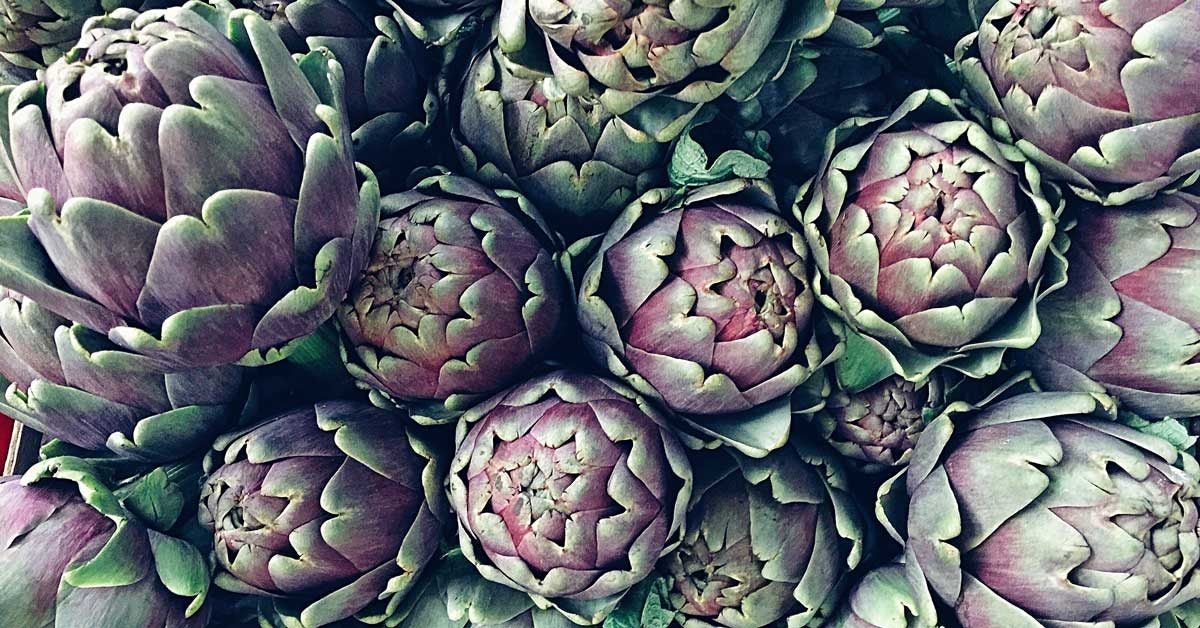Globe artichoke is a perennial that is native to the Mediterranean region. The plant reaches about 1.5 metres and provides fruit (artichoke heads) and leaves that you can use for medicine or tea. It has been consumed as a food source for hundreds of years. The Greeks and Romans ate artichokes to help support their digestion and ensure regular bowel motions. The Egyptians used it to support reproductive ability and conception. We cover everything you need to know about globe artichoke in this blog, including its medicinal uses and how you can use it at home.
The artichoke plant has been cultivated for thousands of years, and with good reason – this versatile vegetable has a wide variety of uses. In this article, we’ll explore the top 5 most popular ways people use the artichoke plant.
1. Culinary Uses
The most common use of the artichoke plant is for food. The edible portion is the immature flower bud, before it blooms into a vibrant purple thistle-like flower
Artichoke hearts are often prepared by steaming or boiling, and then served with a flavorful dip or sauce The meaty texture and mild nutty flavor make artichokes a delicious addition to salads, pastas, pizzas, stews, and more. They can also be stuffed, fried, roasted, or grilled.
In addition to the hearts the fleshy base of the leaves can also be eaten. The thick bases are trimmed off and prepared in similar ways as the hearts.
2. Herbal Remedies
Artichokes have been used for centuries in herbal medicine thanks to their beneficial active compounds like cynarin, apigenin, and luteolin.
Some key medicinal uses of the artichoke plant include:
-
Improving digestion – Artichoke leaf extract stimulates bile production, helping improve digestion and nutrient absorption. The fiber in artichoke hearts also aids digestion.
-
Liver support – Antioxidants like silymarin in artichoke leaves protect the liver and promote bile flow. This helps remove toxins and cholesterol from the body.
-
Lowering cholesterol – The cynarin in artichoke leaves helps lower LDL (bad) cholesterol and raise HDL (good) cholesterol.
-
Soothing upset stomach – Artichoke leaf tea is often used to relieve nausea, vomiting, and other stomach ailments.
-
Anti-inflammatory – Luteolin and other compounds in artichoke leaves reduce inflammation, which may help conditions like arthritis.
3. Skincare
Not only are artichokes good for internal health, they also offer benefits for your skin!
Artichoke leaf extract is rich in antioxidants that protect the skin from sun damage, pollution, and other environmental stressors. It helps improve skin texture, restore moisture, and reduce the appearance of wrinkles and fine lines.
Many skincare products like serums and creams contain artichoke leaf extract for its anti-aging and rejuvenating effects.
4. Natural Dye
The vibrant purple color of artichoke flowers has been used since ancient times as a natural dye for clothing and fabrics.
To make the dye, the flower heads are boiled to extract the pigment. Combined with a mordant like alum, artichoke flower dye produces a range of lavender, mauve, and lilac hues.
Natural artichoke dye is safe and non-toxic compared to synthetic dyes. It’s an eco-friendly way to add beautiful pops of color to textiles.
5. Ornamental Plantings
With their spiky silver foliage and large dramatic flowers, artichokes make a unique ornamental addition to gardens and landscaping.
Artichokes are often used in:
-
Borders – The tall growth habit makes artichokes ideal for garden borders. Plant in a row to create a living fence or privacy screen.
-
Cut flowers – The striking blooms last up to 2 weeks in floral arrangements.
-
Container gardens – Dwarf artichoke varieties do well in large pots on patios and decks.
So while artichokes are delicious to eat, don’t overlook their other versatile uses for health, beauty, crafts and decor! With proper care, these useful plants can provide benefits year after year.
- Culinary uses like salads, appetizers and entrees
- Herbal remedies for improved digestion, liver function, and inflammation
- Skincare products for smoother, younger looking skin
- Natural dye from the flowers to color textiles
- Ornamental plant for borders, arrangements and container gardens
The artichoke is truly a multifunctional plant that keeps giving in so many ways. Get creative with this amazing vegetable and unlock its full potential!
Frequency of Entities:
- artichoke: 39
- plant: 24
- leaf: 10
- flower: 7
- skin: 5
- cholesterol: 3
- culinary: 3
- ornamental: 3
- bud: 3
- extract: 3
- purple: 3
- digestive: 2
- liver: 2
- container: 2
- border: 2
- remedy: 2
- health: 2
- salad: 1
- pizza: 1
- tea: 1
- dye: 1
- landscape: 1
- cholesterol: 1
- stew: 1
- fried: 1
- grill: 1
- nausea: 1
- arthritis: 1
- wrinkle: 1
- fine lines: 1
- mauve: 1
- lilac: 1
- hedge: 1
- privacy screen: 1
- cut flower: 1
- patio: 1
- deck: 1

When to harvest globe artichoke
When harvesting artichoke heads for consumption, choose heads that are dark green and tightly packed. Cut the buds using clippers, leaving 2-3 inches of stem attached. You can harvest in early summer, and it will flower again later in the year (but it will be a smaller crop).
Health benefits of globe artichoke
Globe artichokes love your liver. Often bitter things have an affinity to livers, and globe it is well known for being incredibly bitter. This bitter taste activates your bitter taste receptors (that are found throughout your body) and this starts a chain of reactions within your body that helps support better liver function.
